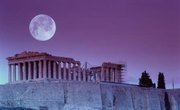English literature is full of light and dark imagery, and the symbolism of a flickering light is particularly suggestive since it's usually about what the light conceals as much as what it reveals. In most British works that feature flickering light, the narrative is about concealment, treachery or hidden motives; the playful flames become the fading moral compass that the protagonists experience.
Early Tales Set by Firelight
The earliest British literature features horrors and moral degradation by firelight. Beowulf dismembers Grendel in the light of the great hall of Hrothgar; the hero goes on to uncertain glory as his epic details his moral decay. The flickering fire of an inn illuminates the tale of the Pardoner in Chaucer's "Canterbury Tales"; one of the most morally reprehensible characters in the pilgrimage, he works a con-artist act by selling indulgences that promise his victims a nonexistent immunity, both from Church prosecution and eternal, flickering hellfire.
Torches in Shakespeare
Shakespeare, doubtless because torches illuminated his plays, has numerous "flickers" in his imagery. Brutus in "Julius Caesar" reads, by the light of meteors, letters that motivate him to murder Caesar. Juliet compares the morning star to an unstable torch that lights Romeo's way into exile. Macbeth reminds us before he murders Banquo that "light thickens," while Iago murders Roderigo and wounds Cassio in a torch-lit alleyway in Cyprus. And Iachimo's soliloquy as he stalks the unconscious Imogen reveals his unwholesome attraction for her by memorializing her in candlelight.
A Novel of Flickers
A classic novel entirely set around symbolic flickering is Rudyard Kipling's "The Light That Failed," in which the flickers are both the literal fading of sight and the moral lapses of its characters. The novel recounts the travails of Dick Heldar, a painter who ignores his own aesthetics and paints for popular tastes. As his talent fades, so does his eyesight. Determined to paint a final masterpiece, he abuses his viciously neurotic model, Bessie Broke, who destroys his painting after his sight is gone, leading him to the ultimate darkness of suicide.
Modern English Flames
The flame of civilization goes out quickly in Golding's "Lord of the Flies" as the boys in the novel go native in the sun and turn cannibal by torchlight, a strong reference to the moral lapses of war-motivated mankind. Ishiguro details the fall of over-civilized British society in "Remains of the Day," set in comfortable mansion rooms lit by firelight. And Mary Stewart, in "This Rough Magic," brings us full circle with her novel about the loss of Camelot, set in innumerable firelit camps.
Related Articles
Writer Bio
Michael Stratford is a National Board-certified and Single Subject Credentialed teacher with a Master of Science in educational rehabilitation (University of Montana, 1995). He has taught English at the 6-12 level for more than 20 years. He has written extensively in literary criticism, student writing syllabi and numerous classroom educational paradigms.











